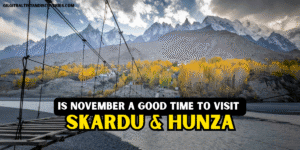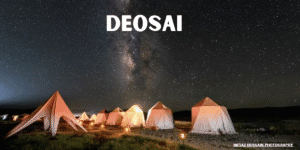Table of Contents
ToggleHistory of Gilgit Baltistan
Introduction
There was a rich history related to the Northern Areas of Pakistan, which included the Gilgit-Baltistan (GB) region in northern Pakistan. The people of this area are known as the Dards, and either classical Greek or Roman historians and ancient Hindu literature refer to them. The Kushan, Chinese, and Tibetan empires ruled the region during its early history and spanned the third to the tenth centuries CE. Tales of Chinese visits from the 7th century refer to the area as Palolo, or Bolor in Arabic, and Arabic and Persian chronicles from the 8th and 9th centuries call it therefore. In this article, we will discuss the history of Gilgit Baltistan.
The Gilgit-Baltistan (GB) region in northern Pakistan was part of the Northern Areas of Pakistan, with a rich historical background. Classical Greek and Roman historians and ancient Hindu texts refer to the people who live there as the Dards. The Kushan, Chinese, and Tibetan families controlled the area in its early history, spanned the third to the tenth centuries CE. Stories from the 7th century about Chinese visits call the region Palolo, or Bolor in Arabic, and accounts from the 8th and 9th centuries from Arabic and Persian chronicles also refer to it as such the historical narratives of the court of Mughal emperor Akbar, such as the Persian chronicle Hodud al-ʿĀlam from the 10th century and the Kashmiri classic Rajatarangini from the 11th century.
Read More: All About Present Gilgit Baltistan
Maqpon Dynasty
In the fourteenth century, Sufi Muslim preachers from Persia and Central Asia brought Islam to Baltistan. Among them was the well-known Mir Sayyid Ali Hamadani, who arrived via Kashmir, while Islam was introduced to the Gilgit region in the same century by Turkic Tarkhan kings. Gilgit-Baltistan was ruled by many local rulers, amongst whom the Maqpon dynasty of Skardu and the Rajas of Hunza were famous. Numerous regional dynasties ruled over Gilgit-Baltistan; two notable ones were the Maqpon dynasty of Skardu and the Rajas of Hunza. Gilgit-Baltistan was united with Chitral and Ladakh by the Maqpons of Skardu, particularly under the reign of Ali Sher Khan Anchan, who had cordial ties with the Mughal court.
During the Anchan dynasty, wealth, art, sports, and a wide diversity of architectural styles existed. He brought polo to the Gilgit region and dispatched a troupe of musicians from Chitral to Delhi to study Indian music. The Mughal architecture also impacted the local architecture. Subsequently, Anchan significantly impacted Abdal Khan, his successor, even if Baltistan’s popular literature still portrays him as a sinister figure known as “Mizos” or “man-eater.”
History of Gilgit Baltistan
Baltistan was an independent country before it merged into the Sikh Kingdom of Jammu and Kashmir in the middle of 1846. But unlike the rest of South Asia, the British never colonized this region. This is mostly because the East India Company sold Gulab Singh to modern-day Jammu and Kashmir when he sided with the British during the first Anglo-Sikh War (1845–1846). Gulab Singh became the first Maharaja of Jammu and Kashmir in 1846. The region of Jammu and Kashmir was divided into four administrative areas following its establishment as a princely state. This included the districts of Jammu and Kashmir, Ladakh, and Gilgit. Baltistan was merged into the Skardu area tehsil in Ladakh in 1840. This remained the continuing administrative arrangement from 1846 forward.
Read More: Things to do in Nagar Valley and Best Places to visit in Hunza and Ghizar Valley
Dynasty of Trakhan
Ahmad Hasan Dani describes the Trakhan Dynasty, which succeeded the Patola Shahis and ruled continuously for over a millennium until the 19th century, by local tradition. He gave a rough reconstruction of the dynasty based on H. Khan and Rais Khan’s history of the area. This story supports coins, inscriptions, and other antiques not discovered during Dani’s lifetime and those that have been found since, contradicting the existence of any such dynasty.
State of Hunza
The principality of Hunza was founded in the 1200s. Later, in a subsidiary alliance with British India, it developed into a princely state from 1892 to August 1947. After three months of nonalignment, it became the princely State of Pakistan from November 1947 until 1974.
Nagar State
Located in the northern region of Gilgit-Baltistan, Pakistan, Nagar was another princely homage state. Founded in the fourteenth century, it was a subsidiary alliance with British India until August 1947.

Kashmir’s Princely State
The Maharajahs Ghulab Singh and Ranbir Singh extended their jurisdiction over Gilgit, Hunza, and Nagar gradually; they did not take control of Gilgit town until 1870. The government of Jammu and Kashmir had a shaky hold on this region. G. T. Vinge was among the first British authorities to explore the area. There was very little British influence in the area. Nonetheless, throughout his journey, Vinge gained the trust of the local Duke of Baltistan and acquired priceless antiquities and manuscripts.
To safeguard the area as a deterrent against the Russians, the Indian government established the Gilgit Agency in 1889 and implemented administrative changes in 1885. The Great Game caused the British to become more fearful of Russian activity in Chinese Sinkiang, which led to the expansion of the Gilgit Agency in 1935. Maharajah Hari Singh leased the Gilgit Wazarat to the Indian government for a cost of 75,000Rs and a tenure of sixty years. In the meantime, the Kashmiri state maintained civil administration, and the British retained control over the defence and foreign affairs. It gives the British political agent total authority over communications, defence, and foreign policy.
End of Princely State
In response to an assault by tribal fighters from Pakistan as a result of the 1947 Poonch uprising and the 1947 Jammu Massacre, Maharaja Hari Singh of Jammu and Kashmir signed the Instrument of Accession on October 26, 1947, becoming a member of India. The people of Gilgit were against the State joining India. Muzzaffar Bangash, the Raja orderly in Chilas, allegedly spoke for the people of the area when he said:
“We could never pledge loyalty to Hindustan because the Gilgit Agency is a Pakistani organization. The Gilgit Agency is part of the NWFP and, hence, part of Pakistan, regardless of religion. Well, that’s fine if Kashmir stays independent. But if the Maharaja joins Hindustan due to political pressure, pigheadedness, poor advice, or alluring compensation, then trouble is brewing!“
Read More: Best Places to Visit in Naltar Valley
Dogar and British Rules
Understanding the region’s strategic significance and anticipating a potential Russian invasion from Central Asia, the British quickly seized the area by establishing the “Gilgit Agency.” With this, Gilgit came under joint British-Dogra rule for the first time.
The British Indian Empire’s primary goal was to defend its northern frontier. They provided the training, gear, and leadership for forming a local paramilitary group, the Gilgit Scouts. The British Indian Government was given direct authority over military and security affairs, but the Dogra kings continued to oversee civil administration. Under a 60-year lease, the British took over the Dogra ruler’s management of Gilgit Agency in 1935. Still, the Dogras maintained direct control over the Baltistan territory.
Pakistani Flag Raising
Following the raising of the Pakistani flag in scout lines on November 2, 1947, Shah Rais Khan was named president, Mirza Hassan Khan was named commander in chief, and Major Brown was named chief military advisor of the Aburi Hakoomat, a provisional administration. But Major Brown had already sent a telegraph to Khan Abdul Qayyum Khan requesting that Pakistan assume command. On November 16, Khan Mohammad Alam Khan, a political operative from Pakistan, arrived and assumed control of Gilgit.
UN Security Council
The provisional administration asked to meet with the political agent on November 18, 1947, stating that he should consult them before making any decisions. India brought the Jammu and Kashmir issue before the UN Security Council on January 1, 1948. A resolution voted by the Council in April 1948 demanded that Pakistan withdraw from all of Jammu and Kashmir, that India reduce its forces to the bare minimum, and that a referendum be held to determine the people’s views.
Sudheendra Kulkarni
But no retreat ever took place, with Pakistan arguing that there was no assurance India would follow and India maintaining that Pakistan had to leave first. Since then, Pakistan has continued to rule over Gilgit-Baltistan and Azad Jammu and Kashmir, a region in the State’s west. Sudheendra Kulkarni, an adviser to former Indian Prime Minister Atal Bihari Vajpayee, claims that the topic of conducting a vote in Gilgit Baltistan was rarely brought up in any of the talks with the Indian leadership, notably Vallabhbhai Patel, discussing a plebiscite in Jammu and Kashmir.
A Section of Pakistan
The Pakistani government established Gilgit Agency and Baltistan Agency between 1947 and 1970. Zulfiqar Ali Bhutto founded the Northern Areas Council in 1970. Then, Gilgit Baltistan was placed under direct federal administration under FANA (Federally Administered Northern Areas). Pakistan relinquished its claim to the Shaksgam Valley in Baltistan. A portion of Hunza-Gilgit, known as Raskam, in 1963 led to the signing of the Pak-China boundary agreement, subject to the resolution of the Kashmir conflict. The Trans-Karakoram Tract is another name for this region.
Northern Areas, Gilgit Baltistan
Formerly known as the Northern Areas, Gilgit Baltistan now comprises ten districts with a population of around two million, covering an area of about 28,000 square miles (73,000 km2) and sharing borders with China, Afghanistan, and India. The army unit that fought in the 1999 Kargil conflict was the local Northern Light Infantry. It was estimated that during that assault, more than 500 men were slain and interred in the Northern Areas. Yasin Valley soldier Lalak Jan was granted Pakistan’s most prestigious medal, the Nishan-e-Haider, for his courageous acts during the Kargil battle.
Read More: Best things to do in Skardu Gilgit Baltistan
Status of Self-Government and The Present Baltistan’s Gilgit
The Pakistani cabinet approved the Gilgit Baltistan Empowerment and Self-Governance Order, 2009, on August 29, 2009, and subsequently signed by the country’s president. The decree established an elected legislative assembly, granting the inhabitants of the former Northern Area, now known as Gilgit Baltistan, self-rule. The Prime Minister of Pakistan unveiled a multibillion-rupee development package on September 29, 2009, at a large assembly in Gilgit-Baltistan, to improve the socioeconomic status of the local populace. The domains of education, health, agriculture, tourism, and necessities of life will all be covered by development programs.
History of Gilgit Baltistan Conclusion
Gilgit-Baltistan’s rich cultural past and unique political structure set it apart. After the Dards first moved there, the region was ruled, among others, by the Chinese, Tibetan, and Kushan dynasties. Famous empires that promoted prosperity and intercultural exchange in the region were the Hunza Rajas and the Skardu Maqpon dynasty.
Baltistan was part of the Sikh Kingdom of Jammu and Kashmir during the colonial era before becoming part of the princely State. Several regional dynasties, such as the Trakhan Dynasty, and states, including Hunza and Nagar, ruled the region. British power increased due to geopolitical factors, establishing the Gilgit Agency and joint British-Dogra control.
Gilgit Baltistan Empowerment and Self-Governance Order, 2009
Gilgit-Baltistan joined Pakistan after gaining independence, experienced administrative changes, and saw the passage of the Gilgit Baltistan Empowerment and Self-Governance Order, 2009, which gave local government more authority. Current policies promote economic growth while improving locals’ living standards. Despite its complex past, Gilgit-Baltistan still has a wide range of cultures and environments, and ongoing efforts are being made to promote socioeconomic development and self-governance there.
Have a look at the best honeymoon places to visit in Pakistan
Read More: Famous Dishes of Gilgit-Baltistan
FAQs About the History of Gilgit Baltistan
How did Gilgit-Baltistan become part of Pakistan?
The rise of the Sikh Empire ended Muslim dominance in the region. Following the Anglo-Sikh wars, in which the British defeated the Sikhs, the Dogras gave the area British supremacy. The Gilgit revolt during the first Kashmir war incorporated the area into the newly established State of Pakistan upon independence.
What is the history of GB?
Current GB was a part of the State of Jammu and Kashmir, one of the biggest princely states in India, before its independence. Following the signing of a treaty between the British and Gulab Singh of the Dogra dynasty, this State was established in 1846.
What are the important facts about Gilgit?
Gilgit-Baltistan may contain all five of Pakistan’s “eight-thousanders” and more than fifty peaks rising above 7,000 meters (23,000 feet). Skardu and Gilgit are the two primary bases of operations for trips to the mountains, and this area contains some of the tallest mountain ranges in the world.
Why is Gilgit-Baltistan not part of Pakistan?
The northern Pakistani territory of Gilgit-Baltistan has a complicated political history. It is a contested area that India and Pakistan both claim. The area was a part of the Muslim-majority princely state of Jammu and Kashmir, which a Hindu Maharaja headed.
Why is Gilgit famous?
Gilgit Baltistan is well known for its stunningly beautiful surroundings. The attractions include amazing history, cold deserts, snow-capped mountains, and unique landscapes with evergreen woods. It is a well-known tourist destination that has long been a mountaineering, trekking, and nature enthusiast’s paradise.







